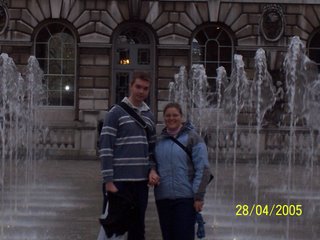
Somerset House is a large building situated on the south side of The Strand in central London, overlooking the River Thames, just east of Waterloo Bridge. The central block of the Neoclassical building, the outstanding project of the architect Sir William Chambers, dates from 1776–1796. It was extended by classical Victorian wings to north and south. A building of the same name was first built on the site more than two centuries earlier.
Somerset House takes its name from the London home of Edward Seymour, Duke of Somerset, who commissioned a riverside mansion on the site in 1547, one of a row of noblemen's houses with fronts along the Strand. The building was constructed from stone removed from some of the chantries and cloisters at St. Paul's Cathedral which were demolished at the behest of Somerset and other leading Protestant nobles as part of the ongoing Dissolution of the Monasteries.
When Somerset fell from grace in 1551 (being executed for treason the following year), the building passed to the Crown and was used by Princess Elizabeth for some years before she was crowned Queen Elizabeth I in 1558.
During the reign of King James I, the building became the London residence of his wife Anne of Denmark and was renamed "Denmark House". She commissioned a number of expensive additions and improvements, some to designs by Inigo Jones. This expansion of the building continued during Charles I's reign, including the then highly controversial addition by his wife, Henrietta Maria, of a Roman Catholic chapel (also designed by Jones – who was later to die at Somerset House, in 1652).
After the English Civil War and the Restoration, Somerset House once again became a royal residence, and was refurbished by Sir Christopher Wren in 1685. During the 18th century, however, the building ceased its royal associations. Though the view from its terraced riverfront garden, open to the public, was painted twice on his London visit by Canaletto (looking upriver and down), it was used for storage, as a residence for visiting overseas dignatories and as a barracks for troops. Suffering from neglect, demolition began in 1775.
As well as the Royal Academy, Somerset House was fitted out to house the Royal Society and the Society of Antiquaries. These, and the Geological Society, moved to Burlington House in Piccadilly in the early 19th century.
In the late 20th century the building was reinvigorated as a centre for the visual arts. The first institution to move in was the Courtauld Institute of Art, including the Courtauld Gallery, which has an important collection of old master and impressionist paintings. In the late 1990s the main courtyard ceased to be a civil service carpark, and the main terrace overlooking the Thames was refurbished and opened to the public, these alterations being overseen by the leading conservation architects Donald Insall & Associates.
A visitor centre featuring audiovisual displays on the history of the building; the gilded Lord Mayor of London's state barge; and a shop and cafe were opened in the wing overlooking the river. The Gilbert Collection of decorative arts, and the Hermitage Rooms, which stage exhibitions of items loaned from the Hermitage Museum in St Petersburg, moved into the same area. The Eastern wing is largely occupied by King's College London.
In the winter the central courtyard is home to an open air ice rink. At other times an array of fountains dispay vertical jets of water rising to random heights.
Somerset House was also the main location for the BBC's New Year Live television show, presented by Natasha Kaplinsky, which celebrated the arrival of the year 2006.
No comments:
Post a Comment